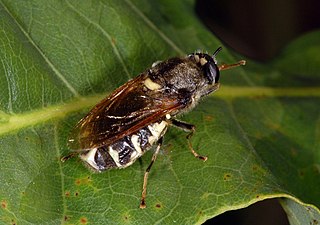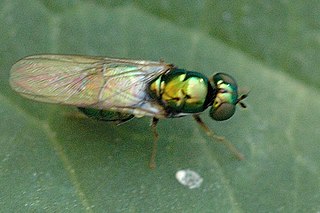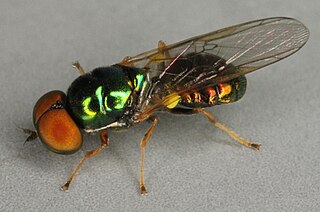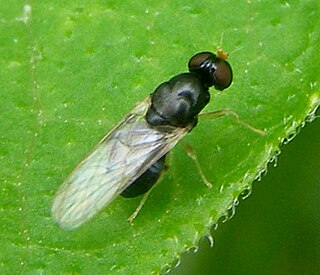
Stratiomys singularia, the flecked general, is a Palearcticspecies of soldier fly.

Sargus iridatus, the iridescent centurion, is a European species of soldier fly.

Sargus cuprarius, the clouded centurion, is a European species of soldier fly.

Microchrysa polita, the black-horned gem, is a species of soldier fly found in Europe, Asia, and North America.

Microchrysa flavicornis, the green gem, is a European species of soldier fly.

Microchrysa cyaneiventris, the black gem, is a European species of soldier fly.

Pachygaster leachii, the yellow-legged black, is a European species of soldier fly.

Pachygaster atra, the dark-winged black, is a European species of soldier fly.

Oxycera pardalina, the hill soldier, is a European species of soldier fly.

Oxycera morrisii, the white-barred soldier, is a European species of soldier fly.

Nemotelus uliginosus, the barred snout, is a Palearctic species of soldier fly.

Nemotelus notatus, the flecked snout, is a European species of soldier fly.

Nemotelus nigrinus, the all-black snout, is a Holarctic species of soldier fly.

Nemotelus is a genus of soldier flies in the family Stratiomyidae. There are at least 190 described species in Nemotelus. Nemotelus is known from the Nearctic, Afrotropical and the Palaearctic regions.

Beris vallata, the orange legionnaire or common orange legionnaire, is a European species of soldier fly.

Beris chalybata, the murky-legged black legionnaire, is a European species of soldier fly.

Beris clavipes, the scarce orange legionnaire, is a European species of soldier fly.

Beris fuscipes, the short-horned black legionnaire, is a European species of soldier fly.

Beris morrisii, the yellow-legged black legionnaire, is a European species of soldier fly.

Beris is a genus of flies in the family Stratiomyidae. They are small flies with reduced palpi. The scutellum has spines and the abdomen has seven visible segments. Their eyes are contiguous in the male.



















